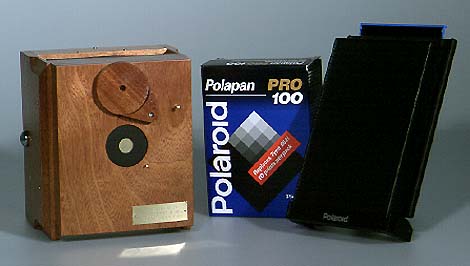
The device that has caused most interest recently amongst creative photographers in Britain is the Robert Rigby Pinhole Camera, which has just been released. At £100 (not including film-back) most people seem to regard it as a rather expensive wooden box. I prefer to think of it as the world's most inexpensive 4 x 5" camera. So how does it work? Simple; light passing through a hole of a given (small) diameter will give a sharp, inverted image at a given distance.

The modern day reinvention of this old concept uses a pinhole of about f/166 - even less at the edges, but donÕt worry about it - and takes three types of camera back. A simple adjustment converts the pinhole camera to take standard 4 x 5" double darkslides and film holders, Polaroid 545, or Polaroid 405 instant film backs. I used the 405 back, which gives a 3.25 x 4.25 inch image with Polapan 100. I expect that superior results could be obtained with 4 x 5 sheet film, Technical Pan or Pan F giving useful exposure times in most conditions.
Two triangles of studs on the top and side of the camera give a rough idea of the angle of view to be expected, but I found it useful to take along an SLR with a 24mm lens and press its base against the side of the camera to get a more accurate impression. The pinhole gives a wider angle than the 24mm lens, probably about 18 - 20mm with the 405 back, but it makes a useful guide. A lens or rangefinder viewer of this type would be ideal.
Exposure is achieved by removing the safety slide and opening the circular shutter/lens cap for the appropriate time. On a bright day with ISO 100 film this can be as little as 1 - 2 seconds, which can cause problems with vibration shake, as well as making precise timing tricky. The best policy is to use as slow a film as possible and a solid tripod.
Pointing the camera into the sun or area of strong reflection resulted in a rather surprising effect. A halo of varying size - wide in this example but smaller in other situations - appears on the image, and is presumably caused by a diffraction of light around the edge of the pinhole. The pinhole equivalent of lens flare!
The other 'special effect' is the vignetting that is due to an effective variation in the aperture between centre and edge. This should be a problem, but somehow seems to enhance the results by focusing attention in the centre of the image, which is in any case, less distorted. Take a look at my view of Murder Moss in Selkirkshire, Scotland - snow in April, but that is normal for Selkirk.
As for special features, the Bob Rigby camera has twin tripod sockets for horizontal or vertical shooting, infinitely variable shutter speeds (as quick as you can flick your wrist), zero distortion, super bright viewfinder (your eyes) and an angle of view that would normally cost real money.
The quality of finish is pretty good - grained wood neatly finished with a brass plaque stamped with the limited edition serial number. The designers, Snowling Associates, tell me that two further versions are on the way, a stereo version and a 'telephoto'.
As a painless introduction to the 4 x 5 format the Rigby camera is unsurpassed. Even as a training tool for photography in general - the basic principles of exposure and how a camera works - it should prove invaluable to schools and colleges. It is fun to use and experiment with and is relatively inexpensive.
It would be nice to imagine that the Robert Rigby Pinhole Camera might be responsible for a few more people developing an interest in photography or even taking the step from 35mm to large format. The most important thing about it is that it changes the way you think about taking a picture, teaching how to use long exposures to create a vast depth of field or including much more foreground or sky detail. Perhaps in future I will find myself taking more of my landscapes at f/22 on my 24mm lens.
It's amazing just how much fun you can get and how much you can learn from a wooden box.